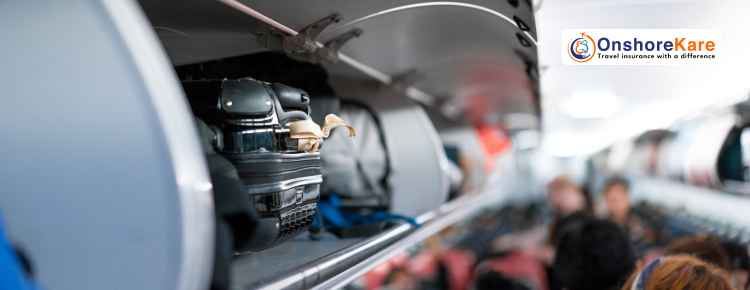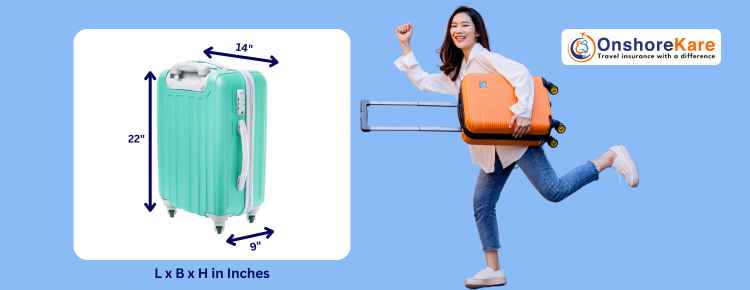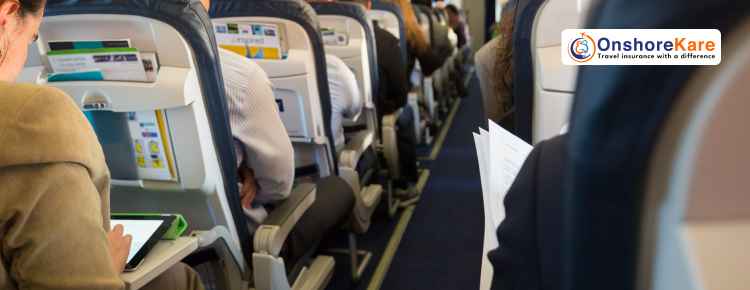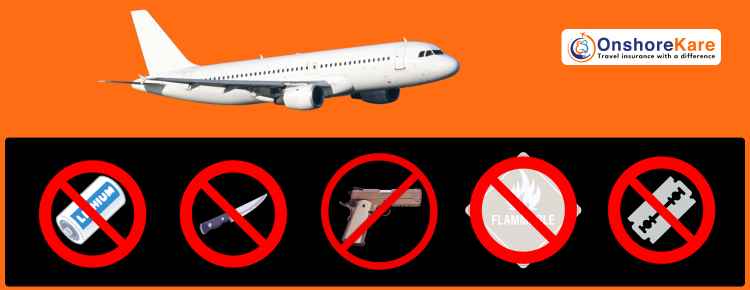
Carry-On Luggage Size: Maximum Allowances By Airline
Understanding carry-on luggage size restrictions is crucial to ensure a smooth and hassle-free journey when preparing for air travel.
Each airline has its own set of rules and guidelines, which can vary significantly. This applies to domestic airlines and international routes.
- Airlines have slightly varying policies regarding the size of carry-on bags.
- Full-size carry-on bags are not always free.
- Avoid being caught off guard at the gate, paying bag fees, and going through the inconvenience.
- Always buy the best carry-on luggage as per the required size limits.
The golden rule is that carry-on luggage must fit in the overhead bin or under the seat in front of you on an airplane. But knowing the specifications of carry-on luggage size will ensure you don’t have to send it as part of your checked bags at the gate.
This detailed guide provides essential information on carry-on luggage size restrictions, helping travelers navigate the complexities and avoid any last-minute surprises at the airport.
Travel Insurance Offers Baggage Protection
When taking international flights you should consider travel insurance.
Evaluate if you need travel medical insurance or trip insurance and buy a suitable insurance plan, explore:
Alongside packing your checked bags and carry-on items efficiently, buying travel insurance is a wise investment for your next trip, protecting you against:
- Trip cancellation.
- Medical emergencies.
- Lost luggage (checked bags and carry-on luggage).
- Pre-existing conditions.
Providing peace of mind and financial protection.
Understanding Carry-On Luggage Rules
What Is A Carry-On Bag?

- A carry-on bag is a piece of luggage that can be stored:
- In the overhead bin, or
- Under the seat in front of you (in an airplane).
- It is typically smaller than a checked bag and is designed to fit in the limited space available on an airplane.
- Carry-on bags are subject to size and weight restrictions, which vary by airline.
- Internationally, a suitcase that is 22″ high and 14″ broad, including the handle and wheels, will be accepted by most smaller, regional, or budget airlines.
- Carry-on bags must weigh less than 35 pounds, 16 inches wide and 24 inches high, and not exceed 10 inches deep.
- Bags must fit in the overhead bins.
What Is A Personal Item?
- A personal item is a small bag that can be taken on an airplane in addition to a carry-on bag.
- It typically is a small purse, briefcase, laptop bag, camera bag, or diaper bag that can fit under the seat in front of you.
- Personal items are subject to size restrictions, which vary by airline.
- On domestic flights, basic economy passengers are subject to a charge for additional personal items and are only permitted to bring one item.
Carry-On Luggage Size Restrictions By Airline
- Most airlines have a standard carry-on bag size of 22 inches tall, 14 inches wide, and 9 inches deep.
- However, some airlines have slightly different size restrictions 21 ” or even less, so it’s always best to check with your airline before your flight.
- Choose smaller carry-on luggage if you’ll be flying with carriers that have more stringent policies or on small aircraft. This guarantees that your suitcase will be accepted by all airlines and spares you from expensive last-minute checked baggage charges.
- Here are some examples of carry-on bag size restrictions for popular airlines:
- American Airlines: 22 inches tall, 14 inches wide, and 9 inches deep.
- Delta Air Lines: 22 inches tall, 14 inches wide, and 9 inches deep.
- United Airlines: 22 inches tall, 14 inches wide, and 9 inches deep.
General Guidelines For Carry-On Luggage
Dimensions And Weight Restrictions

Most airlines have standard carry-on size limits
They allow one carry-on bag typically around 22″ x 14″ x 9″ inches (56 x 36 x 23 cm) (including wheels and handles).
This size limit ensures everyone’s carry-on bags meet the standard limit and fit in the overhead bin of the flight.
However, this can vary, especially on international flights. Weight restrictions also differ, with many U.S. airlines not imposing strict weight limits, while international carriers often enforce limits ranging from 15 to 22 pounds (7 to 10 kg).
Having only carry-on luggage allows you to get to your destination immediately after takeoff, saving you time waiting for checked bags. This is by far the biggest advantage.
Domestic airlines such as Frontier Airlines and Southwest Airlines as a carry-on luggage size limit that allows 24″ x 14″ x 9″.
Personal Item Dimensions

In addition to the primary carry-on bag, passengers are usually allowed one personal item.
This can be a:
- Purse briefcase.
- Laptop bag or laptop computer case.
- Small backpack.
- Generally fitting under the seat in front of you.
The maximum size allowed for a personal item is usually around 18 x 14 x 8 inches (45 x 35 x 20 cm).
Head and neck pillows that fit completely inside your personal item may be brought on board.
Specific Airline Policies
Most airlines have carry-on restrictions it’s always good to read up before a flight on the airline’s website or app on specific policies regarding carry-on luggage size and/or carry-on item-related instructions.
From a big backpack to a little rolling suitcase, everything can be a carry-on bag. The following are the carry-on luggage size limitations for each of the main carriers since size counts more than shape:
U.S. Airlines
Alaska Airlines
Alaska Airlines does not specify any weight limit but specifies that the passenger must be able to lift items that go in the overhead bin.
- Carry-on: 22 x 14 x 9 inches (56 x 36 x 23 cm).
- Personal Item: Must be fitting under the seat in front of you.
American Airlines
Regardless of the kind of ticket purchased, customers on American Airlines (even elite members) are entitled to one carry-on bag and one personal item.
- Carry-on: 22 x 14 x 9 inches (56 x 36 x 23 cm).
- Personal Item: Must fit under the seat in front of you.
Delta Air Lines
Only one carry-on bag and one personal item is allowed
- Carry-on: 22 x 14 x 9 inches (56 x 36 x 23 cm).
- Personal Item: Must fit under the seat in front of you.
Frontier
The carry-on bag must weigh less than 35 pounds and fit in the overhead bin. charges for both checked bags and carry-on bags
- Carry-on: 24 x 16 x 10 inches (61 x 41 x 25 cm).
- Personal Item: Must fit under the seat in front of you.
- Personal items not to exceed 18 x 14 x 8 inches.
JetBlue
No weight limit for carry-on luggage on JetBlue.
- Carry-on: 22 x 14 x 9 inches (56 x 36 x 23 cm).
- Personal Item: Must fit under the seat in front of you.
- Personal items not to exceed 18 x 14 x 8 inches.
Not all JetBlue passengers are allowed the same carry-on items.
- Basic Blue Fares:
- One personal item only.
- Exception: Mosaic customers always get a carry-on.
- Blue, Extra Blue, Blue Plus, And Mint fares:
- One carry-on.
- One personal item.
- Blue Basic Fares (effective Sept. 6, 2024):
- Will include a carry-on.
Southwest Airlines
Only one personal item and one carry-on per traveler are allowed.
- Carry-on: 24 x 16 x 10 inches (61 x 41 x 25 cm).
- Personal Item: Must fit under the seat in front of you.
- Personal items not to exceed 18.5 x 13.5 x 8.5 inches.
United Airlines
Only one carry-on and personal item is allowed.
- Carry-on: 22 x 14 x 9 inches (56 x 36 x 23 cm).
- Personal Item: Must fit under the seat in front of you.
- Personal items not to exceed 17 x 10 x 9 inches.
European Airlines
British Airways
- Carry-on: 22 x 18 x 10 inches (56 x 45 x 25 cm).
- Personal Item: 16 x 12 x 6 inches (40 x 30 x 15 cm).
Lufthansa
- Carry-on: 21.6 x 15.7 x 9 inches (55 x 40 x 23 cm).
- Personal Item: Must fit under the seat in front of you.
Ryanair
- Carry-on: 21.6 x 15.7 x 7.9 inches (55 x 40 x 20 cm).
- Personal Item: 15.7 x 7.9 x 9.8 inches (40 x 20 x 25 cm).
Asian Airlines
Singapore Airlines
- Carry-on: 21.6 x 15.7 x 7.9 inches (55 x 40 x 20 cm).
- Personal Item: Must fit under the seat in front of you.
Spirit Airlines
It’s crucial to measure your bags and ensure they comply with Spirit Airlines’ guidelines to avoid any surprises at the airport.
- Carry-on: 22 x 18 x 10 inches (56 x 46 x 25 cm).
- Personal Item: Must fit under the seat in front of you.
- Personal Item: 18 x 14 x 8 inches (45 x 35 x 20 cm).
Cathay Pacific
- Carry-on: 22 x 14 x 9 inches (56 x 36 x 23 cm).
- Personal Item: Must fit under the seat in front of you.
You can explore the Skiplagged strategy to save money on flight tickets, especially during
Packing Tips For Carry-On Luggage
- Pack light to avoid checked bag fees and make the most of your carry-on space.
- Use a carry-on bag with multiple compartments to stay organized.
- Consider packing a portable charger for your phone or laptop.
- Wear your heaviest or bulkiest items, such as your coat or boots, to save space in your carry-on.
What Is Allowed In A Carry-On Bag?

The Transportation Security Administration (TSA) has specific guidelines on what can and cannot be included in your carry-on luggage. Using travel hacks can deliver big benefits:
General Items
Clothing And Accessories
- All types of clothing, shoes, hats, and accessories.
- Jewelry and watches.
Toiletries
- Liquids, gels, and aerosols in containers of 3.4 ounces (100 milliliters) or less, placed in a single quart-sized, clear, resealable plastic bag (3-1-1 rule)
- Solid toiletries like deodorant sticks and bar soap
- Disposable razors and cartridges
- Duty-free liquids
Electronics
- Mobile phones, tablets, and laptops
- Cameras and camera equipment (excluding large tripods)
- Portable chargers and power banks (must be carried in carry-on bags)
Medications And Medical Supplies
- Prescription and over-the-counter medications in reasonable quantities
- Medical devices and supplies (CPAP machines, diabetic kits, etc.)
- Liquids for medical purposes exceeding 3.4 ounces must be declared at security
Food And Beverages
- Solid food items like sandwiches, fruits, and snacks
- Baby formula, breast milk, and juice (in reasonable quantities)
- Frozen gel packs to keep medical items or baby food cold
Books And Entertainment
- Books, magazines, and newspapers
- E-readers and tablets
- Travel games and puzzles
Specific Items
Personal Care Items
- Hairdryers, straighteners, and curling irons
- Makeup and cosmetics in solid or powder form
- Electric toothbrushes and razors
- Duty-free liquids
Travel Documents And Money
- Passports, boarding passes, and other travel documents
- Wallets, credit cards, and cash
Baby And Child Items
- Diapers, wipes, and changing pads
- Baby carriers and strollers (strollers may need to be checked at the gate)
- Infant car seats (approved for air travel)
Miscellaneous Items
- Umbrellas and walking canes
- Keys and keychains
- Small tools (screwdrivers, wrenches, and pliers shorter than 7 inches)
Prohibited Items In Carry-On Bags

While many items are allowed, certain items are strictly prohibited in carry-on luggage due to safety and security concerns:
Weapons And Sharp Objects
- Firearms, ammunition, and explosive materials.
- Knives, box cutters, and scissors with blades longer than 4 inches.
- Self-defense items like pepper spray and tasers.
Flammable Items
- Flammable liquids and gases (e.g., lighter fluid, propane tanks).
- Fireworks and other pyrotechnic devices.
Sporting Equipment
- Baseball bats, golf clubs, and hockey sticks.
- Archery equipment, spear guns, and martial arts weapons.
Tools And Construction Items
- Hammers, drills, and saws.
- Crowbars and large wrenches.
Tips For Packing Your Carry-On Bag
Follow The 3-1-1 Rule:
- Ensure all liquids, gels, and aerosols are in containers of 3.4 ounces or less and placed in a single quart-sized plastic bag.
Organize Your Bag:
- Keep items you need during the flight, such as electronics and medications, easily accessible.
- Place heavier items at the bottom and lighter items on top.
Check Airline Policies:
- Verify your airline’s specific carry-on size and weight limits, as they can vary.
Declare Necessary Items:
- If carrying medical supplies, baby formula, or items that need special screening, inform the TSA officers.
Use Proper Containers:
- For toiletries and liquids, use leak-proof containers and ensure they are tightly sealed.
Knowing what is allowed in your carry-on bag can save time and reduce stress during the security screening process. By following TSA guidelines and organizing your carry-on bag appropriately, you can ensure a hassle-free travel experience. Always check for the most up-to-date information and specific airline policies before you pack.
Tips For Traveling With Carry-On Luggage
Check Airline Policies
Always verify the specific airline’s carry-on restrictions before your flight. Policies can change, and it’s essential to be up-to-date to avoid any issues at the airport.
Use A Lightweight Bag
Opt for a lightweight carry-on bag to maximize the amount of weight you can pack. This is especially important for airlines with strict weight limits.
Pack Smart
Efficient packing can make a significant difference. Roll your clothes to save space, use packing cubes to organize items, and prioritize essential items to ensure they fit within the size and weight limits.
Prepare For Security
Ensure all liquids are in containers of 3.4 ounces (100 ml) or less and placed in a quart-sized clear bag. Have electronics and other items easily accessible for security checks to expedite the process.
Know The Consequences
If your bag exceeds the size or weight requirements/limits, you may be required to check it, which can incur additional fees. Being prepared can help avoid these unexpected costs.
TSA Liquid Limits For Carry-On Bags
- The Transportation Security Administration (TSA) has strict rules about liquids, gels, and aerosols in carry-on bags.
- Containers must be 3.4 ounces or less and fit in a clear, quart-sized zip-top bag.
- There are some exceptions for medical or mobility devices, such as insulin pumps or breast milk.
Additional Tips For Carry-On Travel
- Make sure your carry-on bag fits under the seat in front of you or in the overhead bin.
- Keep your laptop and liquids easily accessible for security screening.
- Consider using a smart bag with features like GPS tracking or a built-in charger.
- If you have a medical or mobility device, be sure to check with your airline for any special requirements or restrictions.
Camping And Sports Equipment
When traveling with camping and sports equipment, it is important to know what items are allowed in your carry-on luggage. While many items can be carried on board, there are restrictions on certain equipment due to safety and security concerns.
Details About Camping Equipment
Camping Equipment Allowed In Carry-On Luggage:
- Clothing and Gear: Items such as tents (without stakes or poles), sleeping bags, and hiking boots are generally allowed in carry-on luggage.
- Personal Items: Camping-related personal items like compact cookware (without knives), water bottles, and first-aid kits are permitted.
- Electronics: GPS devices, headlamps, and portable chargers can be carried on board.
Camping Equipment Prohibited In Carry-On Luggage:
- Sharp Objects: Tent stakes, poles, knives, and multi-tools with blades are not allowed. These should be packed in checked luggage.
- Flammable Items: Fuel canisters, propane tanks, and other flammable materials are prohibited in both carry-on and checked luggage.
- Fire-starting Tools: Matches and lighters are generally allowed in limited quantities (one book of safety matches or one lighter), but torch lighters and strike-anywhere matches are prohibited.
Details About Sports Equipment
Sports Equipment Allowed In Carry-On Luggage:
- Clothing and Accessories: Sportswear, shoes, and accessories like gloves and hats are permitted.
- Small Equipment: Items such as tennis rackets, baseball gloves, and swim gear can be carried on board.
- Protective Gear: Helmets and pads are allowed as long as they fit within the airline’s size and weight limits for carry-on baggage.
Sports Equipment Prohibited In Carry-On Luggage:
- Large Sports Equipment: Items like baseball bats, hockey sticks, golf clubs, and fishing poles are not allowed in carry-on luggage. These must be checked.
- Projectile Equipment: Items such as bows and arrows, darts, and spear guns are prohibited.
- Weapons: Any sports equipment that can be used as a weapon, such as martial arts tools, is not allowed in carry-on luggage.
Conclusion
Understanding airline carry-on luggage size restrictions and adhering to them can greatly enhance your travel experience. By following the general guidelines and specific airline policies outlined in this guide, you can ensure that your carry-on bag meets the required standards.
Always double-check the specific rules and requirements of the airline you’re flying with, pack smartly, and be prepared for security checks to enjoy a seamless journey.
By being aware of luggage size regulations and having comprehensive travel insurance, you can focus on enjoying your journey without unnecessary stress.
Remember, preparation is key to avoiding last-minute stress and ensuring that your travel plans go off without a hitch. Safe travels!


